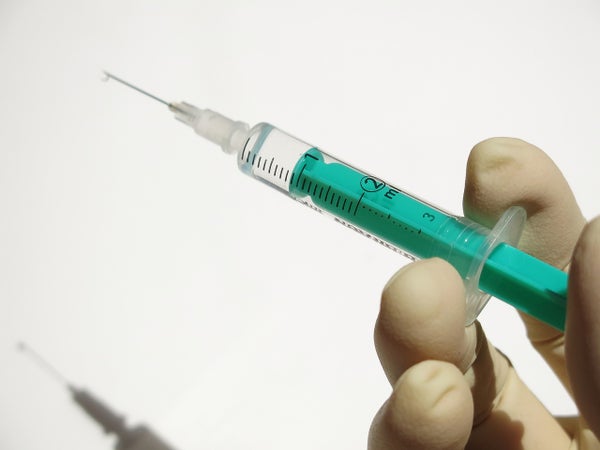This article was published in Scientific American’s former blog network and reflects the views of the author, not necessarily those of Scientific American
For all the blood, sweat and tears that go into designing new medicines, one of the most powerful weapons against disease resides in our own bodies. We just need the right tools to unleash it.
Over millions of years of evolution, our body’s immune system has become exquisitely refined to protect us from foreign invaders such as bacteria and viruses, or from harmful changes arising in our own cells, like cancer. The immune system is the ultimate partner in combatting disease because it has multiple lines of defenses, is adaptable and has memory. Vaccines—perhaps the most transformative breakthrough in the history of medicine—are effective precisely because they harness this unique power. By using vaccines to train the immune system to recognize and attack foreign proteins (called antigens) found in pathogens, we’ve brought infectious diseases like smallpox, polio and measles to their knees.
We may now be in position to effectively use this approach in our fight against cancer. Although the concept of cancer vaccines is not new, a new generation of personalized cancer vaccines could succeed where previous attempts have failed.
On supporting science journalism
If you're enjoying this article, consider supporting our award-winning journalism by subscribing. By purchasing a subscription you are helping to ensure the future of impactful stories about the discoveries and ideas shaping our world today.
The challenge with cancer vaccines—and the reason their history is littered with so many false starts—is that cancer cells very closely resemble healthy cells. Cancer cell proteins have only small changes, generally arising from mutations accumulated while the tumor was developing. Although in some types of cancer there can be several thousand of these mutations, in other cases that number can be less than 10.
Scientists postulated many years ago that cancer-specific mutations are recognized as foreign by the immune system, but only recently have we started to fully understand the extent to which these mutations shape the immune response. These mutations are unique to each individual cancer, and have historically been difficult to identify. Fortunately, rapid improvements in genomic sequencing and computer science have brought us to a point where our lab and others are able to identify and characterize these cancer mutations (called neoantigens) in individual tumor samples.
Scientists are seizing this opportunity to develop new cancer vaccines tailor-made for each patient. The process starts with sequencing the genome of a person’s cancer to identify tumor-specific mutations and predict the neoantigens. That information is used to create a new and unique vaccine. As a result of vaccination, the patient’s immune system learns to recognize and attack the cancer cells expressing those specific neoantigens. It’s the ultimate form of personalized medicine.
Such personalized cancer vaccines have already been tested in the clinic and show promise at stimulating T cell immunity. However, it is likely that any cancer vaccine has to be combined with other treatments, such as other cancer immunotherapies, to harness its full power.
One main reason is that even though the immune system is incredibly well-suited to fight foreign invaders, some cancers can still escape the immune system. In fact, even in cases where the immune system detects the cancer as foreign, cancer cells can prevent T cell attack by expressing proteins called immune checkpoints.
A type of immunotherapy called checkpoint inhibition works by removing these molecular “brakes” on the immune system. Currently approved checkpoint inhibitor immunotherapies are revolutionizing cancer treatment. But while some people show unprecedented efficacy, many people don’t respond at all (typically, the response rates are around 10 to 30 percent). Checkpoint inhibitor immunotherapies appear to work only in people whose immune system has spontaneously/previously recognized cancer cells.
Solving this problem may require a one-two punch: a vaccine that “primes” the immune system to recognize the disease combined with a medicine like a checkpoint inhibitor that “removes the brakes” to enable the immune system to attack the cancer.
The nature of the vaccine can vary, but one promising strategy uses mRNA. These RNA-based vaccines can encode several neoantigens. After injection, the mRNA is taken up and translated into neoantigens by specialized immune cells known as dendritic cells. The mRNA also stimulates dendritic cells to train T cells to recognize these neoantigens. The T cells then seek and destroy cancer cells throughout the body.
RNA is an attractive vaccine delivery platform for several reasons. Compared to DNA-based vaccines, it doesn’t carry the risk of integrating into the host cell genome and making harmful genomic alterations. It has also has the inherent ability to stimulate the immune system, a critical component for vaccine efficacy. Finally, the RNA sequence can be easily customized within the context of a standardized manufacturing process—an important consideration for scaling up the production of such medicines.
The entire process, from genomic sequencing of a tumor sample to delivery of a custom-built RNA-based vaccine, can be completed in a matter of weeks. This turnaround time to develop what is essentially a brand new medicine for each patient is truly unprecedented, and fast enough to be clinically useful.
Unlike any other type of medicine in history, all patients diagnosed with cancer may benefit from these individually tailored treatments. Combined with checkpoint inhibitors or targeted therapies, they could have a dramatic impact on cancer treatment in the near future and may ultimately become the backbone of all cancer therapy.
Evolution has given us an incredible disease-fighting tool in the form of our immune systems. By putting that tool to work, we have great potential to realize a new era of cancer treatment.
